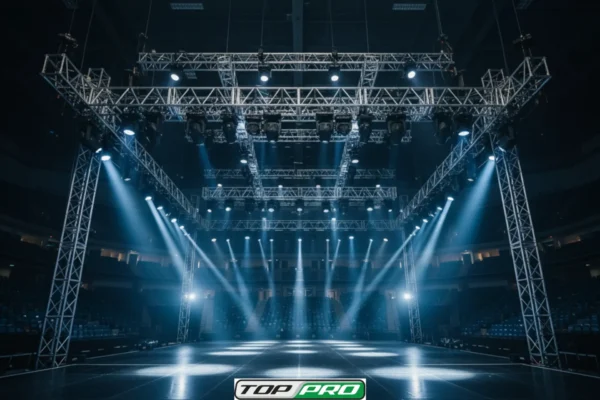Ultimate Truss Buying Guide (2025 Edition)

Most event planners still think of truss as “metal scaffolding” you rent for lights and sound. In 2025, that mindset is outdated. Today’s truss systems are engineered products where safety, sustainability, and performance are non‑negotiable. In this guide, you’ll learn exactly how to choose the right truss so your stage, booth, or show setup is safe, efficient, and future‑proof.
Truss is the backbone of concerts, exhibitions, and live events. The wrong choice can result in wasted budget, unstable structures, or even safety violations. With regulations tightening worldwide—from OSHA in the US to TUV certification in Europe to Dubai Municipality permits—organizers can’t afford trial and error. Add rising material costs and the shift toward portable modular builds, and choosing the right truss becomes a critical investment decision.
What You’ll Learn
- How to Identify the Right Truss for Your Event or Venue.
- Core factors: load capacity, span length, materials, and connection types.
- Pros and Cons of Aluminum versus Steel
- Validation tools and global safety standards you must know.
- Step‑by‑step process for selecting and implementing your truss system.
What is a Truss?
A truss is a rigid framework of interconnected tubes, usually forming triangles, designed to support loads over a span. Think of it as the skeleton of your stage—the hidden structure that makes the lights, screens, and sound equipment possible. The triangular geometry distributes forces evenly, allowing lightweight materials to support heavy loads.
Analogy: A truss works like your bones: strong, lightweight, and designed to carry weight without collapsing.
Why Truss Matters in 2025
- Safety Regulations: Governments now demand certified trusses with load charts and inspection records.
- AI Modeling: Engineers use AI‑driven CAD tools to simulate stress, reducing failure risk.
- Sustainability: Aluminum recycling and modular reuse cut environmental costs.
- Event Scale: Hybrid events demand flexible rigs that can be scaled up or down fast.
Types of Truss
Type | Best For | Pros | Cons | Verdict |
| Box Truss | Large spans, main stages | High load capacity, stable | Heavy, less portable | Best for concerts |
| Triangle | Medium spans, exhibitions | Lightweight, easy setup | Lower load than the box truss | Best for trade shows |
| Flat/Plated | Small booths, décor rigs | Cost-effective, compact | Limited load, short spans | Best for décor/light rigs |
Materials & Connections
Aluminum vs Steel
- Aluminum: Lightweight, corrosion‑resistant, and easier to transport.
- Steel: Heavier but stronger; ideal for permanent installs.
Connection Types
- Bolt Connections: Traditional, highly secure, but slower to assemble.
- Spigot (Conical) Connections: Fast, widely used in rental setups.
- Fork Connections: Heavy‑duty, great for long‑term structures.
Why it matters: Choosing the wrong connection type can slow down your build or compromise safety.
How to Choose the Best Truss Systems?
- Define your load requirements: List equipment weights (lights, speakers, LED screens).
- Match span length to truss rating: Longer spans require a stronger box truss.
- Select material: Aluminum for mobile shows, steel for fixed installs.
- Validate with manufacturer load chart: Never guess—check certified specs.
Example: For a 10m x 8m outdoor stage carrying 250kg of lighting, choose a 12” aluminum box truss with spigot connections rated for 300kg.
Beyond these basics, consider the event environment and compliance requirements. For indoor events, ceiling height and fire safety regulations influence truss size and configuration. Outdoor setups require attention to wind speed data, ballast planning, and corrosion resistance. In regions like the UAE, approvals from local authorities and adherence to ESMA standards are mandatory. It’s wise to create a complete load map showing each piece of gear, then share it with both your supplier and rigging team for review. Budget also plays a role: while an aluminum truss is more expensive upfront, its portability and long lifespan often make it more cost‑effective. Finally, factor in the experience of your crew—spigot connections are faster to assemble, while bolted options may demand more labor but provide extra rigidity.
Tooling & Validation
- Standards to check: TUV (Europe), ISO 9001, OSHA (US), ESMA (UAE).
- Tools: AutoCAD, Vectorworks Spotlight, manufacturer calculators.
- Validation process: Run your rig design in CAD, input load values, and cross‑check against official load charts. If red flags appear, reduce span or switch truss type.
Advanced Connections & Gotchas
- Wind Loads: Outdoor stages require ballast to prevent uplift.
- Load Distribution: Audio gear often weighs more than lighting; balance across the truss.
- Brand Compatibility: Mixing different truss brands may look identical, but can be unsafe due to slight size/connector differences.
Implementation Guide
- Design phase: Map stage dimensions, equipment, and load requirements.
- Select supplier: Verify certifications and rental/purchase terms.
- Transport & logistics: Factor in weight and size for shipping.
- Installation: Use certified riggers; always inspect pins and couplers.
- Inspection: Document setup with photos and compliance reports.
In the UAE, implementation requires careful alignment with local regulations and event industry standards. Before installation, organizers must secure approvals from Dubai Municipality or local authorities, particularly for outdoor events. Certified suppliers are essential, as only trusses with ESMA or TUV certification are typically accepted. Logistics planning should also account for Dubai’s climate—heat, humidity, and sudden wind gusts can affect stability. Using aluminum truss is popular due to its resistance to corrosion in coastal environments. On‑site, professional riggers must follow strict safety practices, ensuring ballast is added outdoors and inspection reports are filed.

QA & Troubleshooting
Common Errors:
- The truss is overloading beyond its rated weight.
- Skipping ballast on outdoor rigs.
- Forgetting safety pins in connectors.
Fixes:
- Recheck load charts.
- Add counterweights or secure with ground anchors.
- Conduct a final walk‑around before the event.
Checklist (Scannable)
- Define event type and load.
- Select truss type (box/triangle/flat).
- Decide on material (aluminum/steel).
- Choose a connection system.
- Verify supplier certifications (TUV, ISO).
- Check load charts.
- Simulate design in CAD.
- Plan logistics for transport.
- Train crew on assembly.
- Use safety pins and couplers.
- Add ballast outdoors.
- Inspect and document setup.
- Run a safety check before the show.
FAQs
What truss size is right for a small event?
For booths or small indoor shows, a 290mm (11.5”) triangle truss is sufficient. Always cross‑check with load charts. See section: Types of Truss.
Can I use indoor truss outdoors?
Yes, but you must add ballast and weatherproof gear. Indoor‑only truss may corrode faster outdoors. See section: Advanced Gotchas.
How do I know if my truss is certified?
Look for TUV or ISO stamps and request the manufacturer’s structural report. Certified truss comes with official load tables. See section: Tooling & Validation.
What’s the lifespan of an aluminum truss?
With proper maintenance and inspection, aluminum trusses can last 10–15 years. Check for dents or cracks after every event. See section: QA & Troubleshooting.







